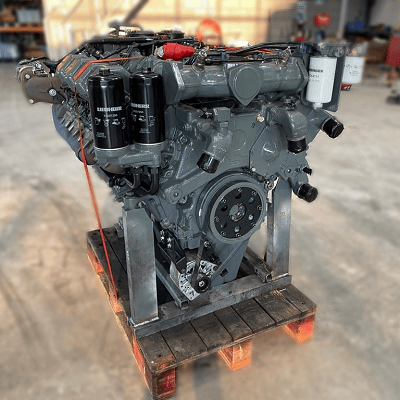The process of a dyno test on a Liebherr engine

When it comes to heavy machinery, reliability and power are paramount. Liebherr, a name synonymous with innovation and excellence in engineering, stands tall as a pioneer in the realm of heavy equipment and machinery. From towering cranes to robust excavators, Liebherr’s engineering prowess extends to the heart of these machines. We delve into the world of dyno testing a Liebherr engine, uncovering the meticulous process behind unleashing the raw power concealed within.
The foundation of excellence
Before we embark on the journey of dyno testing, it’s crucial to understand the foundation upon which Liebherr engines are built. With decades of engineering expertise and commitment to quality, Liebherr engines are crafted to withstand the most demanding environment and deliver unparalleled performance. Each component is meticulously designed and rigorously tested to ensure reliability, efficiency and longevity.
The process
1 Preparation: The engine undergoes meticulous preparation before being mounted onto the dynamo meter. This includes ensuring all connections are secure, fluids are filled to the appropriate levels, and sensors are properly calibrated.
2 Mounting: The engine is carefully mounted onto the dynamometer, a specialized device designed to simulate real-world operating conditions. Precision is paramount during this step to ensure accurate results.
3 Initial checks: Once mounted, a series of initial checks are conducted to verify proper alignment, connection integrity, and functionality of all engine systems.
4 Warm-up: The engine is started and allowed to warm up to operating temperature. This ensures consistent results and minimizes the risk of damage during testing.
5 Baseline testing: With the engine warmed up , baseline tests are conducted to establish initial performance metrics. This includes measuring power output, torque, fuel consumption, and emissions at various RPM levels.
6 Load testing: The engine is subjected to progressively increasing loads to simulate different operating conditions, such as idle, partial load and full load. This allows engineers to assess performance across the entire operating range and identify any potential issues or optimization.
7 Data analysis: Throughout the testing process, data is continuously collected and analyzed in real-time. Advanced instrumentation and software are used to monitor performance metrics and identify trends or anomalies.
8 Optimazation: Based on the data analysis, adjustments may be made to optimize engine performance. This could involve fine-tuning fuel injection timing, adjusting air-fuel ratios, or optimize turbocharger boost pressure.
9 Validation: Once testing is complete, the results are meticulously reviewed and validated against predetermined criteria and specifications. Any deviations or anomalies are thoroughly investigated to ensure accuracy and reliability.
10 Reporting: Finally, a comprehensive report is generated detailing the results of the dyno testing, including performance metrics, observations, and any recommendations for further optimization or refinement.
The outcome of dyno testing
Dyno testing a Liebherr engine is more than just a routine procedure – it’s a testament to the unwavering commitment to excellence that defines Liebherr’s engineering philosophy. By subjecting their engines to rigorous testing and analysis, Liebherr ensures that each engine delivers the uncompromising performance, reliability, and efficiency that customers expect.
In conclusion, dyno testing a Liebherr engine is not just about measuring power output. It’s about unlocking the true potential of these remarkable engines and ensuring they exceed expectations in the most challenging environments imaginable.
PVC Edge Banding For Furniture
The main function of the edge banding is to seal the cross-section of the board, so as to avoid the damage of the board and the adverse factors (mainly moisture) in the process of use and prevent the formaldehyde inside the board from volatilizing, and at the same time achieve the effect of beautiful decoration.
The product has the following main features: smooth surface, no blistering, no ribbing, moderate gloss, smooth surface and back surface, uniform thickness, uniform width, reasonable hardness, high elasticity, good quality, strong wear resistance, trimmed and sealed The color of the side and the side is close to the surface color, not whitish, good gloss, and the overall color of the finished furniture is coordinated.
Furniture edge banding is a material for protecting, decorating and beautifying the section of furniture panels. It can make a piece of furniture show the overall effect of clear wood grain and colorful.
PVC furniture edge banding is relatively light, which is relative to metal and plexiglass. The reason for the lightness is not because it is a polymer compound, but because they are organic compounds, which are composed of carbon, hydrogen, oxygen, and chlorine. And other lighter elements.
The material of pvc furniture edge banding is plastic, which is easy to process. Plastic has plasticity, that is, it deforms after heating or pressurizing, and maintains its original shape after the temperature drops or the pressure disappears. It can be processed into edge bands of their respective shapes by extrusion and other methods, such as T-shaped edge bands, H-shaped edge bands, D-shaped edge bands, V-shaped edge bands, I-shapes, and so on.
pvc furniture edge banding is of high quality and low price, and the price of plastic is far less than that of metal.
PVC Edge Banding For Furniture,Pvc Edge Banding For Furniture, Edge Banding For Furniture,Pvc Edge Banding Tape
Henan Shunbang Chemical Industry CO.,Ltd , https://www.sbpolymer.com